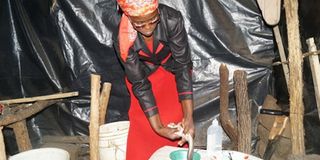How I hatch my fingerlings to earn more

Rhoda Mwende extracts eggs from female catfish in her farm in Embu. She then moves them to the pond. PHOTO | PAULINE KAIRU |
What you need to know:
- Artificial breeding is necessary for the African catfish because the eggs normally enter a dormant phase.
- Learning to breed the fish has given Rhoda a steady supply of fingerlings for sale.
Rhoda Mwende struggles to hold the slippery catfish in her hands. She places it next to a syringe and a bottle of hormones on a table covered with a white gunny bag.
Rhoda cuts a figure of a veterinary surgeon and she has done this several times.
However, she is an ordinary fish farmer who has mastered the process of hatching fingerlings. She learned it all at a fish hatchery in Nyeri.
“I first start with tranquilising the fish for three to five minutes. This immobilises it to allow for the extraction of eggs,” she says as she presses the underbelly of the female fish, starting with the area around the chest.
The eggs flow out in a thick jet into a clean bowl. She repeats the process with several fish she picked from her pond.
“I keep both tilapia and catfish in my four ponds. But while tilapia are prolific breeders, the catfish must be assisted to reproduce.”
She had injected the two fish with 0.3ml of Ovaprim, a synthetic hormone that stimulates ovulation, mixed with 0.2ml of saline about 16 hours earlier. The drugs induce ovulation.
“I went for a week’s training at the farm and mastered it,” says Rhoda, who breeds the catfish artificially in her farm in Kambiti, Embu.
Artificial breeding is necessary for the African catfish because the eggs normally enter a dormant phase.
Maturation and release of the eggs can not be achieved unless the fish is induced to breed through hormonal treatment.
Once she gets the eggs, and sperms from male fish, she mixes in saline water, swirls and transfers the mixture in a bigger trough.
After five minutes of stirring, fertilisation is complete.
The recommended temperature for the embryos to hatch is between 20 and 28 degrees Celsius.
“If the temperature is right, then after 24 to 36 hours, I will have my fries, which is what the fingerlings are called at this stage.”
THE WAY TO GO
Three days later, she will transfer them to an incubation trough where they will stay for another 21 days until they are ready for the pond.
“Here, I feed them boiled egg yolk that I crush and mix with water. But I must change this water every three hours lest it becomes acidic and kills the fry.”
Elijah Kembena, an aquaculture researcher at Kenya Marine and Fisheries Research Institute, Kegati Station says: “This is the way to go for any famer who wants to multiply their catfish cost-effectively since it minimises costs. The other way would be to get them from hatcheries, which can be expensive.”
It is not a complicated process and farmers can learn it fast, he says.
“Ovaprim costs from Sh3,600 to Sh4,000 for a 10ml tube and is available in agrovets. This hormone has been tested and found to have the best results.”
Learning to breed the fish has given Rhoda a steady supply of fingerlings for sale.
“I breed about 2,000 fingerlings from two female fish, and sell them at Sh10 each,” says the farmer, who also rears 3,000 mature catfish for sale at Sh200 each.
She currently has an order of 4,000 fingerlings to supply to a primary school in the county.
She sells between 2,000 and 5,000 fingerlings a month.





